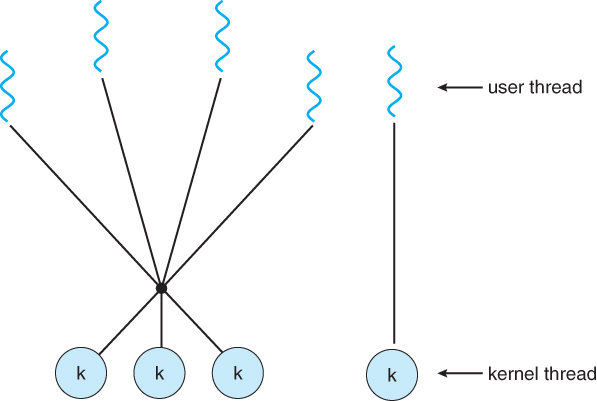Thread in operating systems, play a pivotal role in modern computing by enabling concurrent execution of tasks within a single process. In this article, we will unravel the concept of threads, explore their significance, related terms, and provide simplified examples to illustrate their practical applications.

Understanding Threads:
In the context of operating systems, a thread can be thought of as a lightweight process that exists within a process. Threads in operating system share the same memory space and resources of their parent process but have their own execution flow, allowing for parallel or concurrent execution of tasks.
Types of Threads
- User-Level Threads User-level threads, as the name suggests, operate at the user level and are independent of the operating system’s involvement. They are relatively straightforward to implement since they are managed solely by the user. However, if a user-level thread blocks, the entire process is halted, without the kernel-level thread being aware. This isolation can be both a boon and a bane, depending on the scenario. For instance, languages like Java and POSIX utilize user-level threads.
- Kernel-Level Threads Contrary to user-level threads, kernel-level threads are recognized and managed by the operating system’s kernel. Each thread and process in the kernel level has its dedicated thread control block and process control block. This level of integration allows the operating system to have full visibility and control over the threads. While kernel-level threads offer more robust management and support for multi-threaded processes, they come with added complexity. Context switching between kernel-level threads tends to be slower compared to their user-level counterparts. Notably, systems like Solaris heavily rely on kernel-level threads for their operations.
Essential components that make up threads:
- Stack Space: Threads possess their own stack space, allowing them to manage their execution flow independently.
- Register Set: Each thread maintains its register set, which holds crucial information about its current state.
- Program Counter: The program counter keeps track of the address of the next instruction to be executed within the thread.
Advantages of Thread in Operating System:
- Enhanced System Throughput: By breaking down processes into multiple threads, the system can handle a higher volume of tasks simultaneously, thereby boosting throughput.
- Effective Utilization of Multiprocessor Systems: In multiprocessor environments, threads can be distributed across multiple processors, maximizing resource utilization and improving overall system performance.
- Faster Context Switch: Compared to process context switching, thread context switching is faster, reducing the overhead on the CPU.
- Improved Responsiveness: Thread-based architectures enable quick responsiveness, as individual threads can complete their execution independently, leading to faster overall process response times.
- Streamlined Communication: Threads within the same process share the same address space, simplifying communication and data sharing compared to inter-process communication, which often involves more complex mechanisms.
- Resource Sharing: Threads can easily share code, data, and files within a process, facilitating efficient resource utilization. However, it’s essential to note that threads maintain their separate stack and register spaces, ensuring isolation and preventing conflicts.
Key Concepts and Terminology:
- Process vs. Thread: A process is an instance of a program in execution, comprising one or more threads. Each process has its own memory space and resources. Threads, on the other hand, are lightweight units of execution within a process, sharing the same memory space and resources.
- Multithreading: Multithreading refers to the concurrent execution of multiple threads within a single process. Multithreading enables applications to perform multiple tasks simultaneously, enhancing responsiveness and efficiency.
- Thread States: Threads in an operating system can exist in various states, including:
- Running: Currently executing instructions.
- Ready: Ready to execute but waiting for the CPU.
- Blocked (or Waiting): Waiting for an event or resource to become available.
- Terminated: Finished executing or explicitly terminated.
- Thread Synchronization: Thread synchronization involves coordinating the execution of multiple threads to ensure orderly access to shared resources. Synchronization mechanisms such as mutexes, semaphores, and monitors are used to prevent race conditions and maintain data consistency.
Examples of Threads:
Let’s explore two examples to illustrate the practical applications of threads:
- Parallel Processing:
#include <iostream>
#include <thread>
// Function to be executed by the thread
void printNumbers() {
for (int i = 1; i <= 5; ++i) {
std::cout << "Thread: " << std::this_thread::get_id() << " - " << i << std::endl;
}
}
int main() {
std::thread t1(printNumbers); // Create a new thread
std::thread t2(printNumbers); // Create another thread
t1.join(); // Wait for thread t1 to finish
t2.join(); // Wait for thread t2 to finish
return 0;
}
In this example, we create two threads (t1 and t2) that execute the printNumbers function concurrently, each printing numbers from 1 to 5.
- Graphical User Interface (GUI) Programming: In GUI applications, threads are commonly used to handle tasks such as user input processing, rendering graphics, and updating the user interface. For instance, a separate thread can be employed to handle time-consuming tasks like loading data from a remote server without freezing the user interface.
Also read – Synchronization in Operating Systems
Read in WikiPedia – Thread


